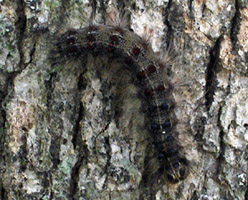Contact: Lynne Richmond
(609) 633-2954
(TRENTON) – New Jersey Secretary of Agriculture Douglas H. Fisher today announced the amount of tree damage caused by gypsy moth caterpillars this spring decreased for the first time since 2003.
The New Jersey Department of Agriculture’s annual gypsy moth aerial defoliation survey showed 91,890 acres of trees experienced some level of leaf loss in the state this year, as compared with 339,240 acres last year.
“The gypsy moth population reached its peak in 2008 and through a combination of regular life cycle drop-off, beneficial fungus and natural predator increases combined with our aggressive spray program, we are pleased to see a downturn,” said Secretary Fisher. “Any amount of tree damage by these destructive caterpillars is significant, so the Department of Agriculture will continue to closely monitor, survey and spray, where necessary, to control the spread of the gypsy moth in the future.”
Most of this year’s damage was moderate to heavy, or between 25 and 75 percent of a tree’s leaves were eaten by the bug. Unlike past years, there was less severe damage due to effective treatments and more activity by the beneficial fungus Entomaphaga maimaiga. Wet weather in May caused the fungus to thrive, killing the caterpillars before they became large. In addition, there were increased established parasite levels, which are helping the gypsy moth population to collapse. Those beneficial parasites were released by the Department decades ago to fight the gypsy moth.
A total of 184 municipalities in 19 counties experienced defoliation this year. Although that was an increase over last year’s total of 134 towns and 17 counties, most counties had significant decreases in the amount of tree damage.
Although Ocean County experienced the most acres of trees defoliated this year, with 16,293 acres, it still had a substantial decrease from 2008, when gypsy moth caterpillars damaged 44,205 acres of trees. Jackson Township saw a large decrease from 22,384 to 4,927 acres.
The survey showed that gypsy moth populations have spread to certain areas of the state, due to natural and wind-borne movement. In high populations, gypsy moths can blow 15 miles during storms, spreading into untreated areas. Seven counties had increased defoliation from last year:
- Cumberland – had the third highest level of defoliation in the state with 13,828 acres of trees damaged. That compares with last year when 3,608 acres were defoliated. The single municipality with the most defoliated acres, Downe Township with 6,080 acres, is in Cumberland County.
- Morris – did not have any defoliation in 2008. Hanover Township was the only town that participated in the aerial spray program. Hanover did not experience any defoliation this year, however 19 other municipalities saw 7,737 acres defoliated.
- Mercer – did not participate in the spray program this year. It saw 1,839 acres defoliated in seven towns, as compared to 127 acres in two towns in 2008.
- Bergen – did not have any defoliation last year and was not part of this year’s aerial spray program, but had 104 acres in six towns.Middlesex – Eleven municipalities experienced 3,299 acres of defoliation this year. In 2008, 9 towns had 2,507 acres of trees damaged.
- Essex – saw an increase from last year, with 759 acres in seven towns defoliated this year and 127 acres in two towns last year. Livingston was the only town to participate in this year’s spray program.
- Salem – had a slight increase this year, with 418 acres damaged in two towns and 326 acres in three towns last year.
The 2009 Gypsy Moth Aerial Spray program included 15 counties, 55 municipalities and 11 agencies with spraying on 35,816 acres of wooded residential and park land, wooded areas along the Garden State Parkway and areas of Earle Naval Weapons Station.
This year, the United States Forest Service provided $1,480,472 in cost reimbursement funds to municipalities participating the Department of Agriculture’s spray program. That represented 23 percent of the amount paid by the towns for the service.
An aerial tree mortality survey conducted last year by the Department of Agriculture and the New Jersey Department of Environmental Protection’s Division of Parks and Forestry observed a total of 30,902 acres of trees killed by repeated defoliations by gypsy moth caterpillars since 2006.
Two to three consecutive years of significant defoliation (defined as 75 percent or more) can kill an otherwise healthy tree. However, any gypsy moth defoliation can make trees more susceptible to other damage that can lead to the death of the tree. Oak trees are the preferred host for gypsy moths, but the caterpillars can be found feeding on almost any tree in the vicinity.
“The main goal of the Department’s gypsy moth suppression program is to prevent the loss of trees and protect our forests, which are important wildlife habitats as well as filters for the air we breathe,” said Secretary Fisher. “We will continue to work cooperatively with the state DEP, the U.S. Forest Service and New Jersey’s congressional delegation to ensure this program is available to assist towns experiencing problems with gypsy moth caterpillars.”
Starting next month through January, the Department will conduct egg mass surveys in towns that request it to determine what areas qualify for next year’s spray program. If the residential or recreational forest has an average of more than 500 egg masses per acre, and is at least 50 acres in size it may qualify for participation in the program. Municipal participation in the aerial spray program is voluntary.
Each year, since 1970, gypsy moth caterpillars have caused varying degrees of defoliation -- between 1,910 and 800,000 acres of forested land.
To access the detailed 2009 New Jersey Gypsy Moth Aerial Defoliation survey and for more information on New Jersey’s gypsy moth suppression program, visit: www.nj.gov/agriculture/divisions/pi/prog/gypsymoth.html. Also, for national gypsy moth material, visit www.na.fs.fed.us/fhp/gm/.



